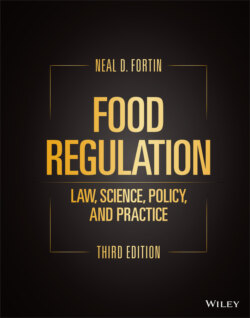Читать книгу Food Regulation - Neal D. Fortin - Страница 203
DISCUSSION QUESTION
Оглавление1 4.3. Infant food. Why did FDA decide to prohibit nutrient content claims on infant and toddler foods?
* * * * *
Good Reading for Good Eating
Paula Kurtzweil, FDA CONSUMER, SPECIAL ISSUE, FOCUS ON FOOD LABELING 33
It may not have the power of a Pulitzer prize‐winning novel or the luridness of a checkout counter tabloid, but the new food label still promises to make for good reading….
[T]erms used to describe a food’s nutrient content—“light,” “fat‐free,” and “low‐calorie,” for example—will meet government definitions so that they mean the same for any product on which they appear. Health claims about the relationship between a nutrient or food and a disease that are supported by scientific evidence will be allowed for the first time.
Serving sizes:
are more consistent across product lines to make comparison shopping easier.
are expressed in common household and metric measures.
better reflect the amounts people really eat.
There will be many more products with labels to read because the regulations, for the first time, make nutrition labeling mandatory for almost all processed foods. Also, uniform point‐of‐purchase nutrition information will accompany many fresh foods, such as fruits and vegetables and raw fish, meat, and poultry.
The new food label is reading that can be put to good use, too, because it’s designed to help clear up much of the confusion that has prevailed on supermarket shelves. It also can help consumers choose more healthful diets. And it can serve as an incentive to food companies to improve the nutritional qualities of their products.
“[This isn’t] just another government program,” said FDA Commissioner David Kessler, M.D. “The new food label is an unusual opportunity to help millions of Americans make more informed, healthier food choices.”
“We expect the labels also will provide more food companies with an incentive to improve the nutritional quality of their products,” said H. Russell Cross, Ph.D., FSIS administrator.
….
Advertising is not covered by the Nutrition Labeling and Education Act, but the Federal Trade Commission has indicated it may apply the same criteria to advertising that FDA and FSIS do to labels.
….
A Look Back
…
“The line from industry used to be: ‘Nutrition won’t sell food. It’s price, taste and convenience,’” [Ed Scarbrough] said.34 “By the time we got into the 1980s, nutrition clearly was selling products. Industry recognized this and started making claims about the food.”
That was both good and bad, Scarbrough said. On the one hand, it gave consumers more information about nutrition. But on the other, claims got pushed to their outer limits as manufacturers scrambled to gain a competitive edge for their products.
“Consumers reacted to that,” he said. “They couldn’t believe many of the claims being made.”
At about the same time, the Surgeon General of the U.S. Public Health Service and the National Academy of Sciences’ National Research Council released two reports that lent strong support to development of a new food label. These reports—the 1988 Surgeon General’s Report on Nutrition and Health, and the 1989 National Research Council’s Diet and Health: Implications for Reducing Chronic Disease Risk—concluded that evidence substantiates an association between diet and risk of chronic disease and recommended similar dietary changes.
Those recommendations reflected what many public health experts had been saying for years: for example, that Americans should reduce their intake of fat (especially saturated fat), cholesterol, and sodium; maintain appropriate body weight; and consume adequate amounts of calcium and fiber….
It soon became apparent, however, that the [old] food label did not offer enough information to help consumers follow those guidelines. That, coupled with often questionable marketing practices, led to the first serious effort to revamp the food label….
According to John Vanderveen, Ph.D., director of FDA’s Office of Plant and Dairy Foods and Beverages, the law makes the United States the first country in the world to have mandatory nutrition labeling and to allow health claims on food labels. “We’ve been pioneers,” he said….
….
Economic Impact
It is estimated that the new food label will cost FDA‐regulated food processors between $1.4 billion and $2.3 billion over the next 20 years. However, the benefits to public health—measured in monetary terms—are estimated to well exceed the costs. Potential benefits include decreased rates of coronary heart disease, cancer, osteoporosis, obesity, high blood pressure, and allergic reactions to food.
….
* * * * *
